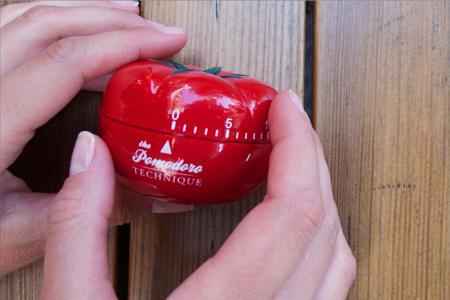Can This Time Management Tip Stop Procrastination?
Published: Mar 15, 2017

At one point or another, we’ve all struggled with time management. Whether it be staying late at the office to put the final touches on a presentation or pulling an all-nighter to finish a paper, working under a time crunch is never fun. Yet it can be hard to motivate yourself to begin a project well before the due date, especially if you’re surrounded by a million distractions. What if there were a technique guaranteed to make you stop procrastinating and help you effectively budget your time? Well, there is—it’s called the Pomodoro Technique.
Invented in the late 1980s by Francesco Cirillo, the Pomodoro Technique is a time management strategy proven to help people maximize efficiency when working. The technique involves working for set intervals of time and taking scheduled breaks, which teaches you to work with time instead of against it. Not only will it make you more productive, but it can help you manage distractions effectively and make you less susceptible to burnout.
So how exactly does it work? The technique comprises six easy steps:
1. Select a task
Choose a project you’d like to complete, whether it be finishing a deck at work or writing a term paper for class. Jot the task down on a piece of paper.
2. Set a timer for 25 minutes
This will be your first “pomodoro,” or interval of 25 minutes of uninterrupted work. (In developing a name for this technique, Cirillo decided on “pomodoro” because it means “tomato” in Italian; the original kitchen timer he used as a university student was shaped like a tomato.)
3. Work on the task until the timer rings
Focus all your attention on the task at hand for the next 25 minutes. If something important distracts you during that time, write it down on a piece of paper, but keep working.
4. Place a checkmark next to the task
Once the 25 minutes is up, put a mark next to the task you worked on during that pomodoro.
5. Take a short break (3–5 minutes)
Give your brain a rest and grab a cup of coffee, answer a text, or chat with a coworker. Now is a great time to follow up on any quick, pressing tasks that popped up during the 25 minutes.
6. After every 4 pomodoros, take a longer break (15–30 minutes)
Two hours of concentrated work is significant, and it’s important to take a break so your brain can assimilate the new information and rest before the next round of Pomodoros.
Using the Pomodoro Technique can help you in the short term and long term. By handling distractions during break periods, you effectively “schedule” them and cut down on wasted time. And in checking off all your pomodoros each day, you will gain not only a sense of accomplishment, but also a physical list of all the items you worked on that day.
This list can prove helpful in showing you exactly how much time you spend on certain types of assignments. It can help you better predict the time required for you to complete future projects, so you can allocate your time accordingly. In this respect, the Pomodoro Technique is a key tool that will not only help you manage your responsibilities now, but also help you set and achieve goals in the future.
